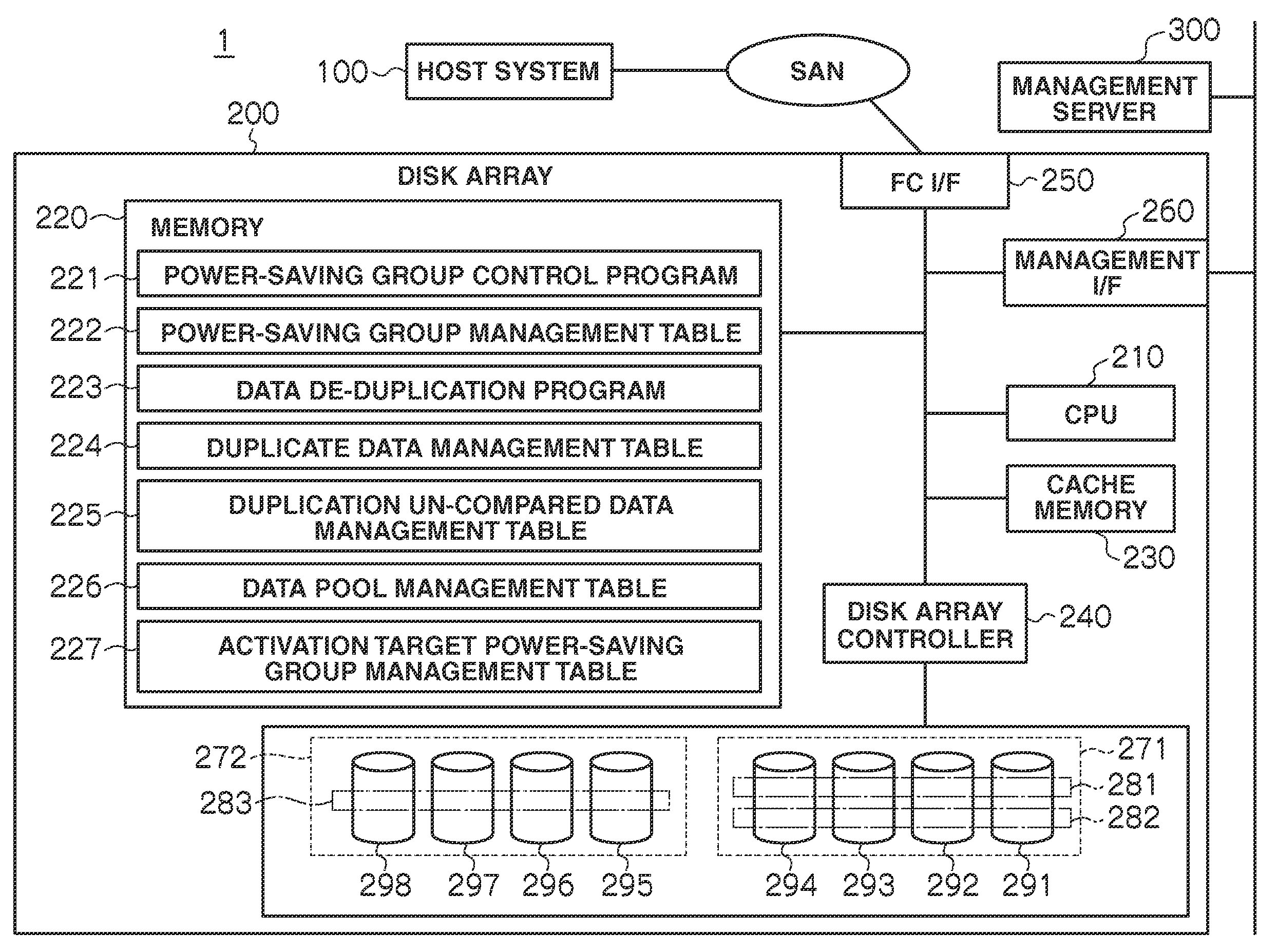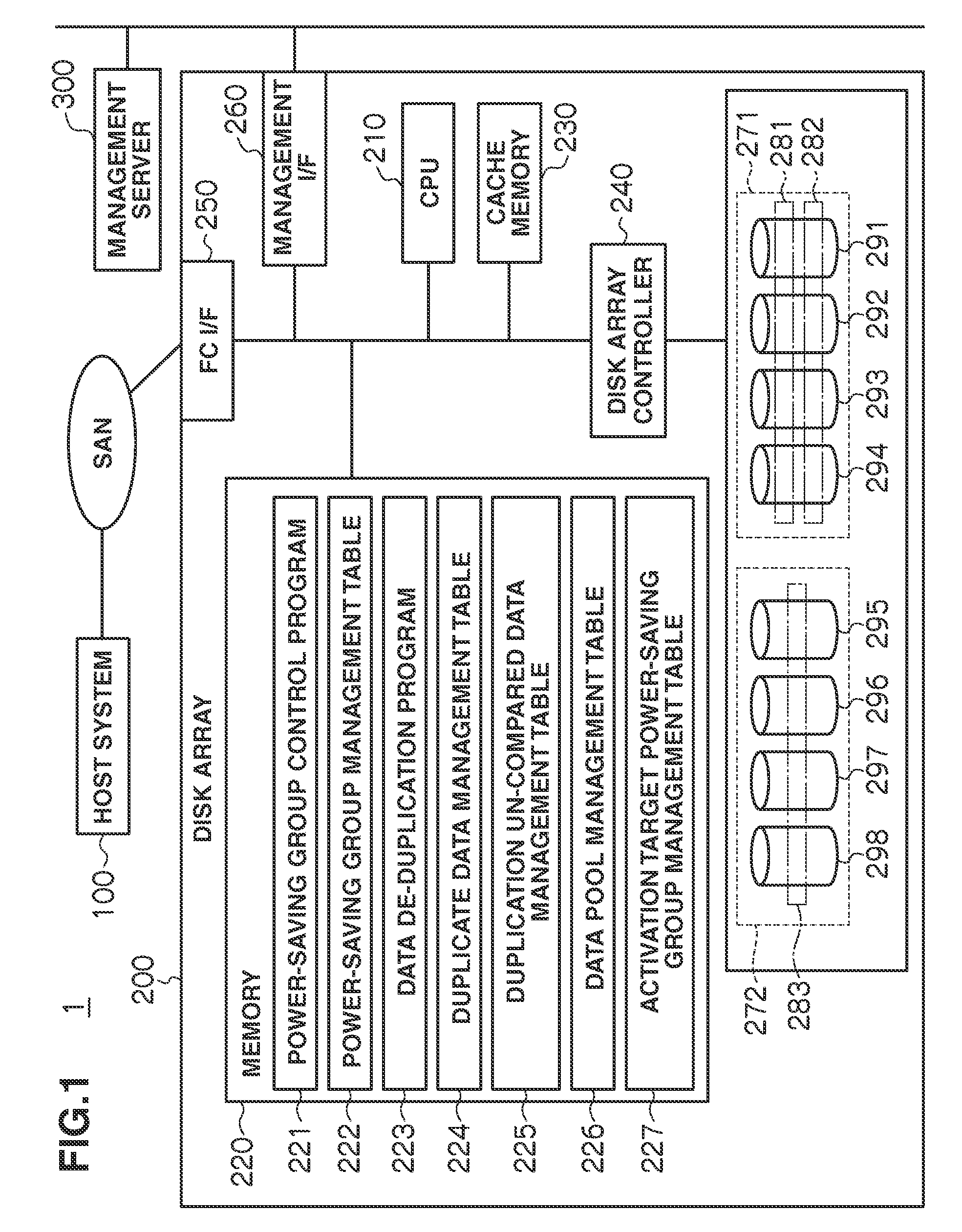Storage system and power consumption reduction method for the same
a technology of storage system and power consumption reduction, which is applied in the direction of liquid/fluent solid measurement, micro-instruction address formation, instruments, etc., can solve the problems of unnecessary disks, increased power consumption in the entire disk array, and inability to achieve efficient disk operation control, etc., to achieve maximum data capacity efficiency and power-saving
- Summary
- Abstract
- Description
- Claims
- Application Information
AI Technical Summary
Benefits of technology
Problems solved by technology
Method used
Image
Examples
embodiment 1
(1-1) Configuration
[0026]FIG. 1 shows an example of the configuration of a storage system 1. In FIG. 1, a host system 100—a computer with an application program for business or similar running—and a disk array 200 storing data transmitted from the host system 100 are connected to each other via a SAN (Storage Area Network). Note that although FIG. 1 shows only one host system 100 as a computer in FIG. 1, there may be more than one computer in practice.
[0027]The disk array 200 has a Fibre Channel interface (“FC I / F”) 250 connected to the SAN, and a management interface (“management I / F”) 260. Note that the management I / F 260 is used when sending / receiving the data in the disk array 200 to / from other apparatuses such as a management server 300. The FC I / F 250 is used when sending the data written in the disk array 200 to the host system 100 or receiving the data to be written in the disk array from the host system 100.
[0028]The disk array 200 also has a CPU 210 for controlling the dis...
embodiment 2
(2-1) Configuration
[0118]The configuration of a storage system in Embodiment 2 is the same as that of the storage system 1 in Embodiment 1 so explanations will be omitted.
(2-2) Power Consumption Reduction in Disk Array
[0119]Power consumption reduction in Embodiment 2 is the same as that in Embodiment 1 so explanations will be omitted. However, in Embodiment 2, of the power-saving groups, one or more power-saving groups (“permanently-active groups”) are defined as groups that are always active and so accessible while the disk array 200 is in operation.
(2-3) Data De-Duplication
[0120]Data de-duplication in Embodiment 2 is the same as that in Embodiment 1, so explanations will be omitted.
(2-4) Power Saving Control Involving Data De-Duplication
[0121]Power saving control in Embodiment 2 is the same as that in Embodiment 1 except for the points below, so explanations will be given only for the differences.
[0122]Unlike Embodiment 1, in Embodiment 2, the above permanently-active groups are u...
embodiment 3
(3-1) Configuration
[0126]The configuration of a storage system in Embodiment 3 is the same as that in Embodiment 1, so explanations will be omitted.
(3-2) Power Consumption Reduction in Disk Array
[0127]Power consumption reduction in Embodiment 3 is the same as that in Embodiment 1 so explanations will be omitted.
(3-3) Data De-Duplication
[0128]Data de-duplication in Embodiment 3 is the same as that in Embodiment 1 so detail explanations will be omitted. However, in Embodiment 3, the data de-duplication program 223 divides the write data the host system 100 sends to the disk array 200 into segments and calculates hash values for those segments. The size of the segments may differ according to the specifications for the data de-duplication.
(3-4) Data De-Duplication Involving Power Saving Control
[0129]Explanations will be given below only to the differences from Embodiment 1.
[0130]Unlike Embodiment 1, in Embodiment 3, write data is divided into segments. The host system 100 recognizes th...
PUM
 Login to View More
Login to View More Abstract
Description
Claims
Application Information
 Login to View More
Login to View More - R&D
- Intellectual Property
- Life Sciences
- Materials
- Tech Scout
- Unparalleled Data Quality
- Higher Quality Content
- 60% Fewer Hallucinations
Browse by: Latest US Patents, China's latest patents, Technical Efficacy Thesaurus, Application Domain, Technology Topic, Popular Technical Reports.
© 2025 PatSnap. All rights reserved.Legal|Privacy policy|Modern Slavery Act Transparency Statement|Sitemap|About US| Contact US: help@patsnap.com



